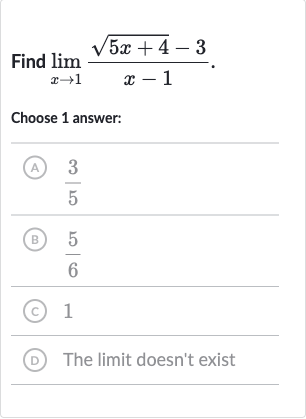Full solution
Q. Find .Choose answer:(A) (B) (C) (D) The limit doesn't exist
- Identify the form: Identify the form of the limit.We need to find the limit of the function as approaches . Let's first substitute with to see if we can directly evaluate the limit.We get an indeterminate form , which means we need to apply a different method to evaluate the limit.
- Apply algebraic manipulation: Apply algebraic manipulation to simplify the expression.To resolve the indeterminate form, we can multiply the numerator and the denominator by the conjugate of the numerator. The conjugate of is .
- Perform the multiplication: Perform the multiplication in the numerator.When we multiply the conjugate pairs in the numerator, we get a difference of squares, which simplifies to:The denominator remains as .
- Simplify the expression further: Simplify the expression further.We notice that the numerator can be factored out as . This will allow us to cancel out the term in the denominator.After canceling out the terms, we get:
- Evaluate the limit: Evaluate the limit of the simplified expression.Now that we have simplified the expression, we can directly substitute with to find the limit.

